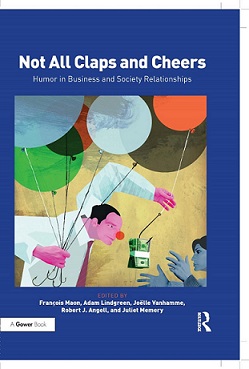Professor Adam Lindgreen publishes new book on the use of humor in business and society relationships

Together with François Maon, Joëlle Vanhamme, Robert Angell, and Juliet Memery, Professor Adam Lindgreen has edited a new research anthology: Not All Claps and Cheers: Humor in Business and Society Relationships.
Scholars from various disciplines have studied humor since antiquity. Yet over the centuries, these researchers also have struggled to conceptualize a viable, well-accepted notion of humor. The challenge continues to confound us and elude clear definition. Beyond pleasure and amusement, people use humor for a variety of social functions. For example, it might facilitate and enhance learning processes; help reorient perceptions, attitudes, and behaviors; and facilitate social relationships. Two central functions of humor are to facilitate communication in specific contexts and to spread aggressive messages. On the one hand, humor can cause others to like the humorous source more, attract regard, ease conversations, promote expression and the exchange of ideas, introduce new topics of discussion, or smooth interactions. On the other hand, in aggressive forms, humor can halt verbal interactions, modify the usual rules of conversation, communicate critiques, or contribute to create subversive environments. In this context, the mobilization of humor by individuals, groups, and businesses constitutes a research field of increasing interest. However, the use of humor by business actors in interactions with external stakeholders other than consumers, and the ways external stakeholders similarly use humor to influence business actors, remain poorly addressed. In particular, research that focuses on developing a constructive understanding of business and society relationships and interactions lacks specific analyses of the use of humor, even though humor is growing in popularity and use among external stakeholder groups that address corporations. The role of humor and the comic frame in criticisms targeted at the business world and in the expression of associated aspirations for systemic adaptation and corporate social change is significant.
Not All Claps and Cheers: Humor in Business and Society Relationships is an original research anthology that considers different angles from which to address the use of humor by individuals, groups, and business actors in their interactions within, around, and across organizations—that is, at the interfaces of business and society. Accordingly, the research anthology is organized in four sections. Section 1, entitled “Humor, Business and Society,” comprises two introductory chapters that delineate and critically reflect on the humor notion on the one hand and the business and/in society field on the other. The goal is to provide a constructive basis and interesting routes to approach the anthology’s three other sections. Section 2, “From Society to Business: Humor’s Use and Roles in Activist Movements,” addresses how external stakeholders and civil society initiatives have mobilized humor in their efforts to highlight and denounce negative corporate impacts, change the status quo from the outside, or rebalance business and society relationships. This section also evokes potential utopian or disillusioning aspects that may characterize such crusades and how humor can play a role in this context. Section 3 is labeled “From Business to Society: Humor’s Use and Roles in Marketing, Corporate Communications, and Public Relations.” It features chapters that aim to highlight, analyze, and synthetize the ways that companies engage in developing humor-laden signals, messages, and practices when interacting with and trying to influence their external stakeholders—particularly, their customer bases. Section 4, entitled “Society within Business: Humor’s Use and Roles in the Workplace and in Organizations,” addresses the internal life of the business organization and the ways that humor, in its diverse forms, can influence activities, relationships, and organization’s functioning in society. The chapters in this last section scrutinize the potential positive effects and impacts of humor-related attitudes and initiatives on organizational life, as well as the darker, toxic sides of humorous activity that can develop within organizational settings—just like in broader society. The related mechanisms entail asserting the superiority and dominance of some organizational members and groups over others, as well as control- and power-related dynamics in organizations.
The research anthology has been endorsed by leading academics in the field:
“Laughter, a famous Irishman once said, “is wine for the soul”. Imbibe this book forthwith. You’ll clap. You’ll cheer. You’ll smile. You’ll stagger. You’ll feel better about business life. You’ll remember its lessons for ever. Probably.” - Professor Stephen Brown, Ulster University, Northern Ireland.
“Humor is pervasive in a multitude of situations, and business settings are no different. Buying, selling, and promoting are just a few of the commercial domains where the positivity of humour comes into its own. This original book explores the role of humor in a wide range of marketable dealings and from an extensive variety of perspectives. From psychology to media studies and from marketing to linguistics, contributors are leading international experts from diverse academic fields thus rendering the collection both interdisciplinary and well and truly global, too.” - Professor Delia Chiaro, University of Bologna and President of the International Society of Humor Studies 2015-17.
“The editors have brought together leading scholars from a variety of disciplines who work in academic and applied settings to produce the most comprehensive volume of cutting-edge, up-to-date research on the social functions of humor in organizational settings. This book is an important resource that tops the list of “must reads” for basic and applied researchers, and students of humor and organizational psychology. This well-written volume demonstrates that humor can be a double-edged sword within an organization, showing that an organization’s humor climate can be either positive or negative, having beneficial or detrimental effects on organizational culture by affecting the psychological well-being and performance of individual employees and by affecting the quality of interactions among workers, as well as the function of the organization as a whole. In addition to looking within an organization, this volume addresses the ways that companies use humor in marketing and advertising to relate to and engage the general public.” - Dr. Thomas E. Ford, Western Carolina University and Editor of Humor – International Journal of Humor Research.